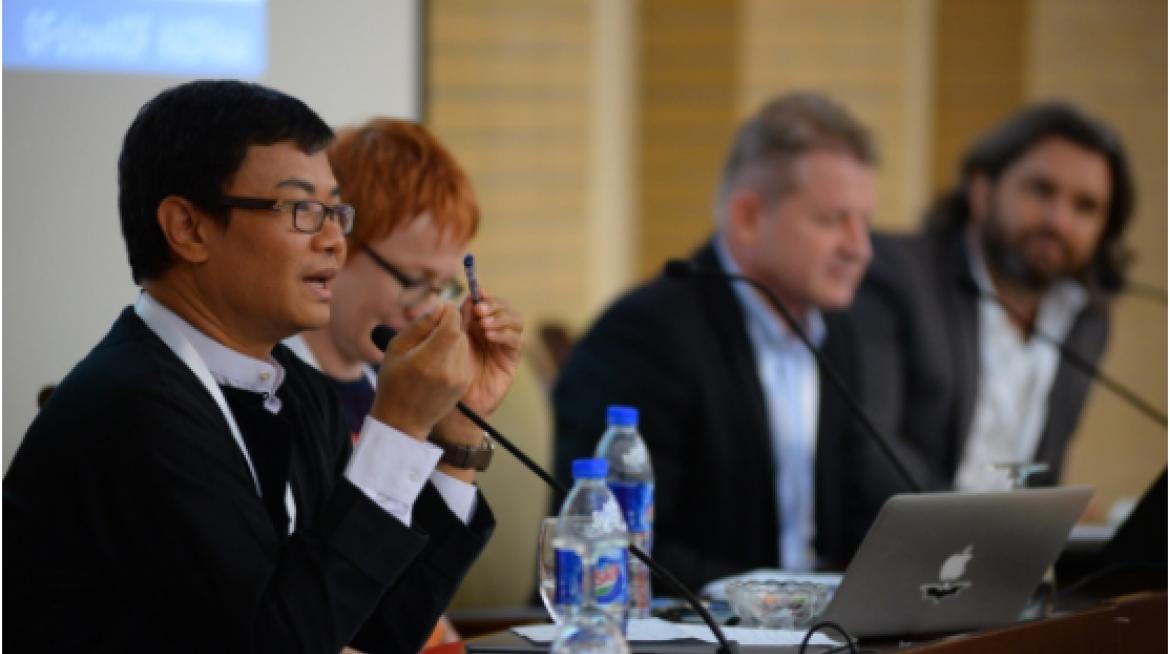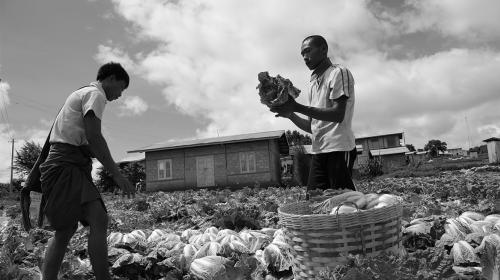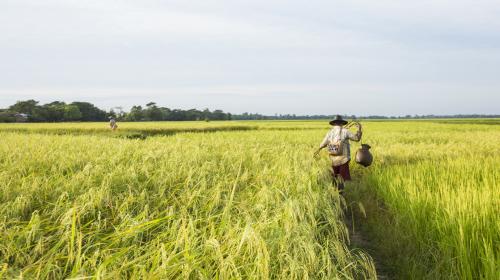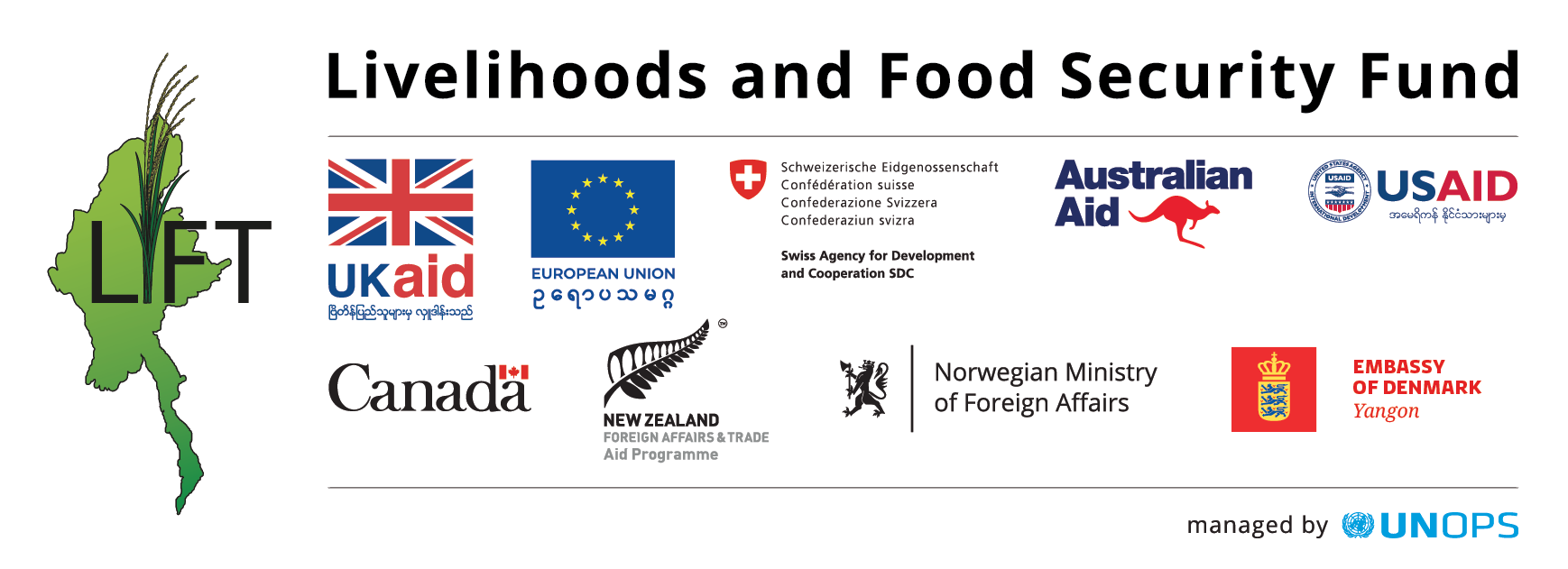
LIFT was honored to participate in Aid and Development Summit Asia held in Nay Pyi Taw in Myanmar on 14 and 15 June. More than 200 people from the Government, UN Agencies, local and international NGOs, local and international private companies, investors and civil society organizations engaging in various development sectors such as health, water and sanitation, financial inclusion, and agriculture. Exchanging expertise and networking between local and international communities was great achievement of the forum. Myint Kyaw, Program Officer of Financial Inclusion from LIFT participated in a panel discussion on issues linking digital finance and rural development. Other speakers were Paul Luchtenburg, Country Representative of UNCDF Myanmar, and Steven Harley from Wave Money. Alix Zwane, Director of Global Innovative Fund moderated the discussion. Myint Kyaw shared his experience of panel discussion.
Mobile Money for Financial Inclusion
The panel started the discussion by sharing experience of mobile money development in Kenya and explored opportunities and challenges of replacing cash based programs in Myanmar with digital finance.
When mobile money was introduced in Kenya in 2006, percentage of people accessed to bank was very low i.e., 26 percent and 75 percent of remittance was done through informal channels. After 10 years, the percentage of people accessed to bank increased to 70 percent due to increase in use mobile money services. Increase in use of mobile money in Kenya was spurred by diversity of services such as remittance, payment, credit and saving. Those diverse services helped users to be cashless but easier access to financial services. M-PESA is one of leading mobile money service providers in Kenya. According to a study of Development Economics, M-PESA helped an estimate of 2 percent of the people in Kenya graduated from poverty.
Success of mobile money services can also be found in South East Asia countries. As an example, with strong mindset within the Central Bank, Philippine, a country with many islands introduced mobile money quite early i.e., in 2001. SMART Money and GCASH were major mobile money services providers and they started offering domestic and international cash transfers to the users, and later followed with other services such as loan payment, salary payment, and bill payment. Not only the persons but also institutions are clients of the mobile money services. TPSI, a microfinance institution used the mobile money services for loan disbursement and repayment collection. Others such as MercyCorps and Department of Social Welfare and Development replaced high cost cash disbursement with cash transfer through mobile money services in their relief programs.
Mobile Money Service Has Opportunities to Scale Up Through Rural Finance Sector Development in Myanmar
In Myanmar, mobile penetration was sharply increased from 12% to 85% within three years. The Central Bank of Myanmar (CBM) issued two major regulations for digital financial services (DFS): (1) digital banking directives (Dec, 2013) through banks (bank-led model) and (2) mobile financial service regulations (Mar, 2016) through telecoms operators (telco-led model). Wave Money in partnership with Yoma Bank and Telenor mobile operator was the first mobile money service provider registered at the Central Bank as per 2016 regulation. Within two months after launch, it reached to more than 100,000 users through 5,500 agents. Other mobile operators such as MPT and Ooredoo are also ready to enter to niche mobile money market.
Rural finance service providers such as microfinance institutions and Myanmar Agricultural Development Bank (MADB) are potential to partner with mobile money services in order to scale up their outreach. Recent changes in microfinance regulation allowed microfinance institutions to increase their single loan size up to Kyat 10 million (an approximate of USD 7,350). This change raised interest of microfinance institutions in payment system through mobile money service.
MADB was transferred from Ministry of Agriculture, Livestock, and Irrigation to Ministry of Planning and Finance in April 2017. It has a plan to scale up hire-purchase scheme for agricultural equipment (also called as term loan) with concessional loan from JICA. Both MADB and microfinance sector disbursed more than 4.8 million loans in 2016 in total.
There are also initiatives in mobile money services within Government and Non-Government sectors. The largest State Owned Bank, Myanmar Economic Bank introduced payment to pensioners from Government sector through Inwa Bank’s Myanmar Mobile Money in 2015. UN World Food Programme started using mobile money payment services in its cash transfer programs in Kachin State in Myanmar in partnership with Wave Money.
Challenges in Myanmar
Inclusive mobile finance regulation is still required. In Myanmar’s financial sector, there are different regulators for different financial institutions. For example, Central Bank regulates private banks while Ministry of Planning and Finance regulates State Owned Banks, insurance business and microfinance institutions. Therefore, the regulation issued by each regulator is not comprehensive enough to address issues of the whole financial sector. For example, mobile financial service regulation in 2016 issued by the Central Bank did not address services of rural finance service providers. For example, maximum amount for daily transaction (business to person) allowed by the mobile financial service regulation is Kyat 1 million. This amount is too small for microfinance institutions to disburse single loan size (business to person) Kyat 10 million.
Support to private sector for financial inclusion through mobile money service is needed. Experience of mobile money in other counties highlighted that mobile money contributes to financial inclusion when its services are diverse such as remittance, credit, savings, insurance, etc. However, without support from donors, Government and development partners, outreach of mobile money service to people with low income will be challenging. WFP’s initiative of transferring cash through mobile money service experienced high cost providing mobile phones, and organizing training for agents and users. Without donors’ support, financial inclusion among people in emergency and relief camps cannot be achieved.
Ways Forward for Discussion
Microfinance law allows cash transactions through mobile money. But, there is no specific microfinance regulation issued by the Government for microfinance transactions through mobile. Separate mobile money regulations by Ministry of Planning and Finance can cause complication and confusion to the financial sector. Therefore, mobile financial service regulation issued by the Central Bank should be reviewed and amended in a way of inclusiveness i.e., services of microfinance institution can be transacted through mobile money.
In early stage, serving to people with low income especially in rural areas is not priority among the mobile money service providers. The Government, donors, and development partners should partner with private sector such as banks, telecoms companies, digital financial service providers for financial inclusion through mobile money services such as access to saving and credit through mobile money services.





